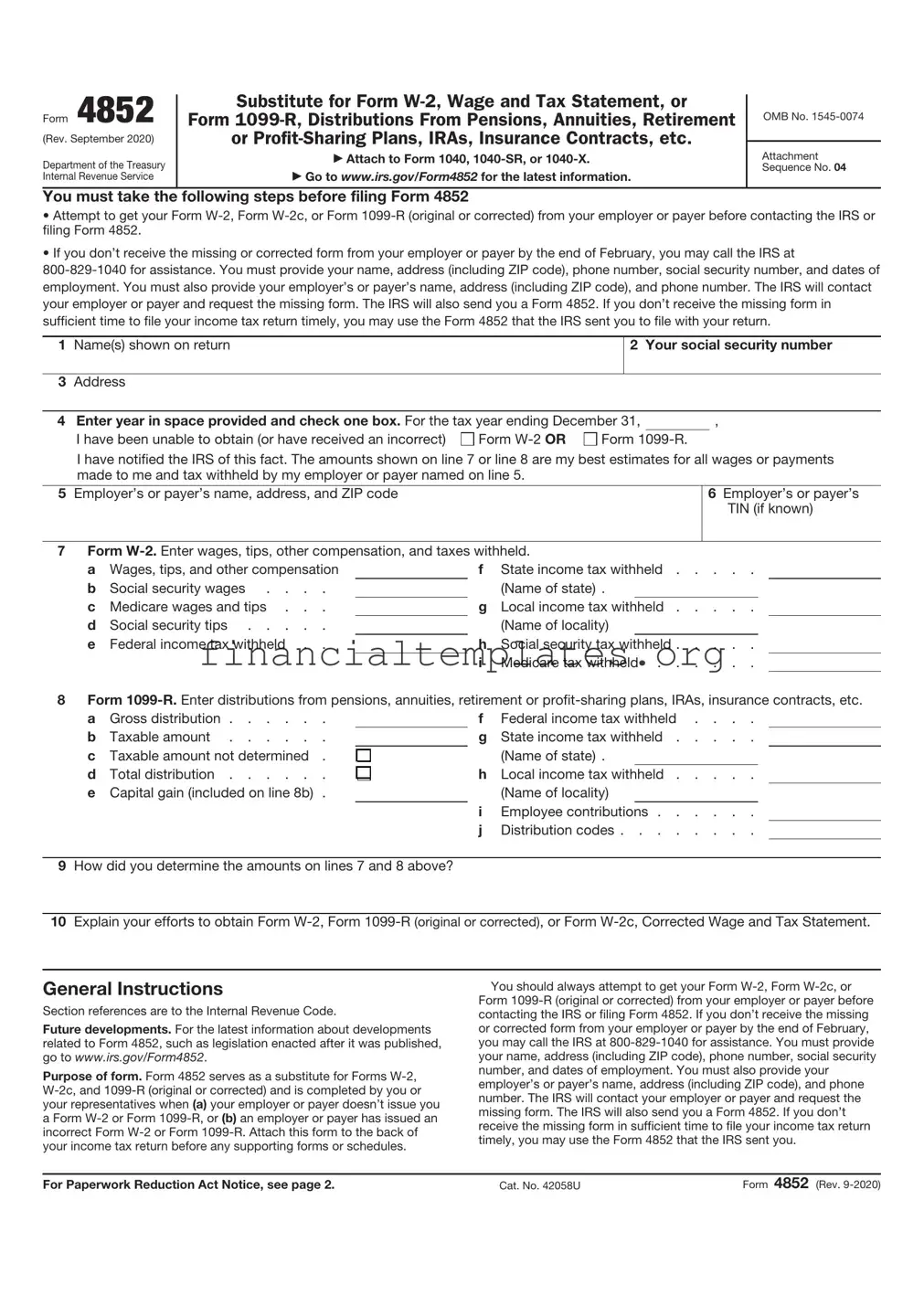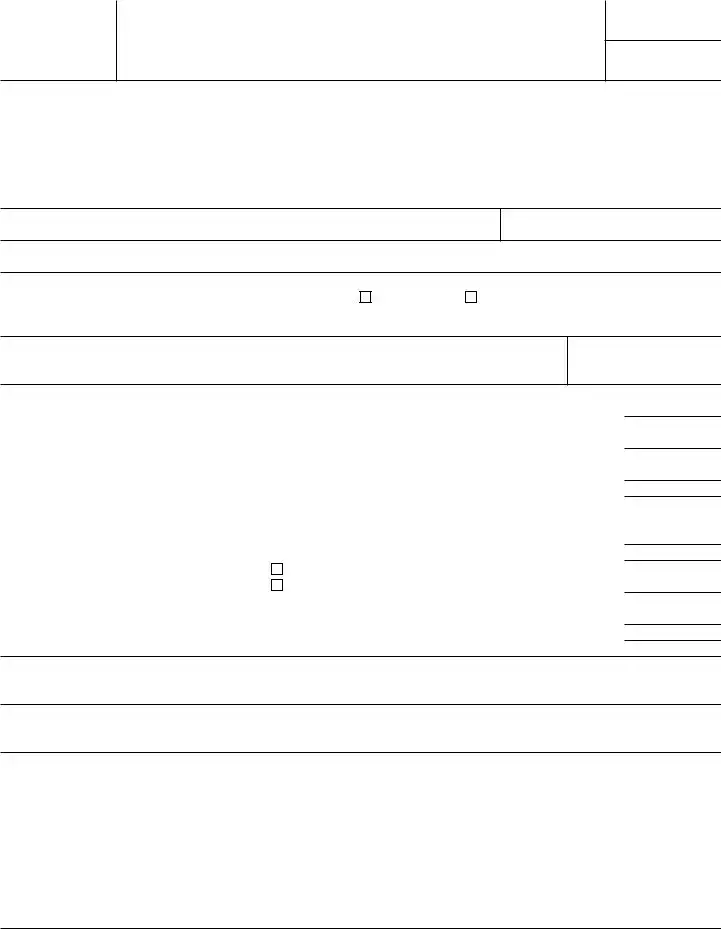If you received an incorrect Form W-2 or Form 1099-R, you should always attempt to have your employer or payer issue a corrected form before filing Form 4852.
Note: Retain a copy of Form 4852 for your records. To help protect your social security benefits, keep a copy of Form 4852 until you begin receiving social security benefits, just in case there is a question about your work record and/or earnings in a particular year. After September 30 following the date shown on line 4, you may use your Social Security online account to verify wages reported by your employers. Please visit www.SSA.gov/myaccount. Or, you may contact your local SSA office to verify wages reported by your employer.
Will I need to amend my return? If you receive a Form W-2, Form W-2c, or Form 1099-R (original or corrected) after your return is filed with Form 4852, and the information you receive indicates that the information reported on your original return is incorrect, you must amend your return by filing Form 1040-X, Amended U.S. Individual Income Tax Return. You are responsible for filing your income tax return with accurate information regardless of whether you receive a Form W-2, Form W-2c, or Form 1099-R (original or corrected) and regardless of whether the information on any forms received is correct.
Penalties. The IRS will challenge the claims of individuals who attempt to avoid or evade their federal tax liability by using Form 4852 in a manner other than as prescribed. Potential penalties for the improper use of Form 4852 include:
•Accuracy-related penalties equal to 20% of the amount of taxes that should have been paid,
•Civil fraud penalties equal to 75% of the amount of taxes that should have been paid, and
•A $5,000 civil penalty for filing a frivolous return or submitting a specified frivolous submission as described by section 6702.
Specific Instructions
Lines 1 through 3. Enter your name, social security number, and current address including street, city, state, and ZIP code.
Line 4. Enter the year for which Form W-2 or Form 1099-R wasn’t received or was incorrect.
Line 5. Enter your employer’s or payer’s name, address, and ZIP code.
Line 6. Enter your employer’s or payer’s taxpayer identification number (TIN), if known. If you had the same employer or payer in the prior year, use the employer identification number (EIN) shown on the prior year’s Form W-2 or Form 1099-R. If you don’t know the EIN, but you know a different TIN associated with the employer or payer, such as a social security number (SSN), you may enter that TIN.
Line 7—Form W-2. To the extent the Form W-2 you received reported correct information, complete line 7 by entering that correct information. If you don’t have complete and accurate information from a Form W-2, use your final pay stub to help complete line 7. For additional information, get Form W-2 and the General Instructions for Forms W-2 and W-3.
a—Wages, tips, and other compensation. Enter your total wages received (include wages, noncash income, tips reported, and all other compensation before deductions for taxes, insurance, etc.).
b—Social security wages. Enter your total wages subject to employee social security tax. Don’t include social security tips and allocated tips.
c—Medicare wages and tips. Enter your total wages and tips subject to Medicare tax. This amount may be required to be entered on Form 8959, Additional Medicare Tax. See the Instructions for Forms 1040 and 1040-SR to determine if you are required to complete Form 8959.
d—Social security tips. Enter the tips you reported to your employer for the year. The total of lines 7b and 7d can’t exceed the social security wage base for the year reported on line 4. The total amount of tips received during the year should be included on line 7a. You can find the social security wage base for any given year at www.SSA.gov/OACT/ COLA/cbb.html. The social security wage base for a given year can be found in Pub. 15 (Circular E), Employer’s Tax Guide, for that year, usually under What’s New at the beginning of the publication.
e—Federal income tax withheld. Enter the amount of federal income taxes withheld from your wages for the year. Include the 20% excise tax withheld on excess parachute payments on this line.
f—State income tax withheld. Enter the amount of state income tax withheld from wages for the year. Enter the name of the state.
g—Local income tax withheld. Enter the amount of local income tax withheld from wages for the year. Enter the name of the locality.
h—Social security tax withheld. Enter the amount of social security tax withheld (not including the employer’s share), including social security tax on tips.
i—Medicare tax withheld. Enter the amount of Medicare tax withheld (not including the employer’s share). This amount includes the 1.45% Medicare tax withheld on all Medicare wages and tips you report on line 7c, as well as the 0.9% Additional Medicare Tax withheld on any of those Medicare wages and tips above $200,000. For more information on Additional Medicare Tax, go to www.irs.gov/AdMT.
Line 8—Form 1099-R. To the extent the Form 1099-R you received reported correct information, complete line 8 by entering that correct information. If you don’t have complete and accurate information from a Form 1099-R, use a distribution statement from your plan trustee to help complete line 8. For additional information, get Form 1099-R and the Instructions for Forms 1099-R and 5498.
a—Gross distribution. Enter the total amount you received for the year as a gross distribution.
b—Taxable amount. Enter the taxable amount of your distribution.
c—Taxable amount not determined. Check this box if you are unable to compute your taxable distribution. If you check this box, leave line 8b blank.
d—Total distribution. Check this box only if the payment shown on line 8a is a total distribution.
e—Capital gain (included on line 8b). Enter the capital gain on your lump-sum distributions that you also included on line 8b. Only certain individuals can elect to treat lump-sum distributions as a capital gain on Form 4972, Tax on Lump-Sum Distributions. See the Instructions for Form 4972 for details.
f—Federal income tax withheld. Enter the amount of federal income tax withheld.
g—State income tax withheld. Enter the amount of state income tax withheld. Enter the name of the state.
h—Local income tax withheld. Enter the amount of local income tax withheld. Enter the name of the locality.
i—Employee contributions. Enter your investment in the contract (after-tax contributions), if any, recovered tax free this year.
j—Distribution codes. Enter the distribution code or codes that apply. If you are reporting more than one code, separate the codes with a comma. See the Instructions for Forms 1099-R and 5498 for a complete list of codes. If your distribution was from a traditional IRA, SEP IRA, or SIMPLE IRA, write “IRA,” “SEP,” or “SIMPLE” in the right margin.
Line 9. Explain how you determined the amounts on line 7 or 8. For example, tell us if you estimated the amounts, used your pay stubs, or used a statement reporting your distribution.
Line 10. Explain any attempts made to get the missing or corrected Form W-2, Form 1099-R, or Form W-2c from your employer or payer.
Paperwork Reduction Act Notice. We ask for the information on Form 4852 to carry out the Internal Revenue laws of the United States. You are required to give us the information. We need it to figure and collect the right amount of tax.
You are not required to provide the information requested on a form that is subject to the Paperwork Reduction Act unless the form displays a valid OMB control number. Books or records relating to a form or its instructions must be retained as long as their contents may become material in the administration of any Internal Revenue law. Generally, tax returns and return information are confidential, as required by section 6103.
The average time and expenses required to complete and file this form vary depending on individual circumstances. For the estimated averages, see the instructions for your income tax return.
If you have suggestions for making Form 4852 simpler, we would be happy to hear from you. See the instructions for your income tax return.


